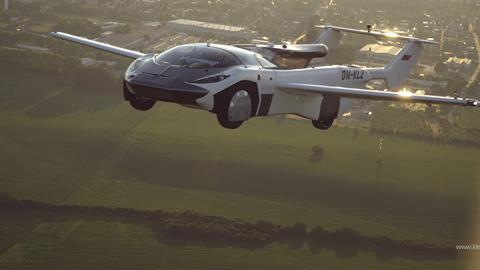The prototype ‘AirCar’ has been deemed airworthy but lawyers warn that it needs to navigate a host of legal and practical obstacles – such as meeting civil aviation standards – in order to get off the ground
Hopes – or fears – of flying cars becoming an everyday means of transport are far from reality despite a technical breakthrough, specialist aviation lawyers said this week.
The breakthrough was the announcement that the prototype ‘AirCar’ had been granted a certificate of airworthiness by the authorities in its maker’s native Slovakia. In principle, that would be recognised by the UK Civil Aviation Authority, though the UK is no longer a member of the umbrella European Aviation Safety Agency. ‘AirCar certification opens the door for mass production of very efficient flying cars,’ said Professor Stefan Klein, AirCar’s inventor and test pilot. ‘It is official and the final confirmation of our ability to change mid-distance travel forever.’
However, Adam Baker, a partner in the aviation practice at national firm Weightmans – and a qualified fixed-wing and helicopter pilot – said that certification was only the first of many legal and practical hurdles. Even though the AirCar’s innovations include automatic takeoff and landing software, its pilot will need at least a private pilot’s licence to fly it legally. That requires time, money and medical checks. ‘Some people simply won’t have the aptitude to fly an aircraft,’ Baker said.
To remain airworthy, the car would also need to be maintained to civil aviation standards – far higher than the annual MOT test for road vehicles, which are typically used much more intensively than private light aircraft.
Another issue is that of fuel. AirCar’s wheels and pusher propeller are driven by the same 1.6-litre BMW petrol engine. But Baker pointed out that it could not be filled up at any pump: approved aviation fuel is from approved suppliers, kept in approved storage and tested every day for water ingress. However, the untaxed ‘avgas’ sold at airports may not legally be used on public roads.
Meanwhile, the boast that, with its ingenious folding wings and retractable tail, AirCar can switch modes from ground to air within three minutes is diluted by the security procedures of driving airside at an airstrip and the need for routine pre-takeoff checks.
Another flying lawyer, Andrew Krausz, head of Weightmans’ aviation team, pointed to a wider issue. A fixed-wing flying car which needs to operate from airstrips essentially reflects the status quo regime in general aviation. ‘Is there a political appetite for enlarging the regime, apparently to benefit the very wealthy?’, he asked. Civil aviation is already under pressure over its environmental impact: the prospect of the skies filling with flying cars would raise questions of noise, carbon emissions and air traffic control. ‘There is a high risk of collision, ground damage. All this needs to be thought out.’
This does not mean that flying cars – a dream of inventors for more than a century – will never happen. But Krausz predicts that the practical version will need to be vertical take-off, fully automated and continuously communicating to avoid collisions, and powered either by battery or possibly hydrogen. ‘The main issue is the extent to which people are willing to be carried by a vehicle without a pilot,’ he said.
More than 80 years ago, Henry Ford said: ‘Mark my word: a combination airplane and motorcar is coming. You may smile, but it will come.’ History may one day prove him right, but for all the technical genius behind AirCar, the practical everyday combined aircraft and car is unlikely to look much like either.



































No comments yet